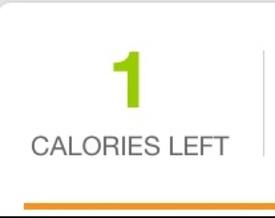Calorie in vs calorie out?

thewhiteswan78
Posts: 9 Member
Hi guys,
I'm new to this and only started yesterday. The thing I'm confused about is my projected calories for the day. It recomends 2100, and then based on what I eat and exercise, changes accordingly. The thing is, if I eat near or on my 2100, I have also exercised and the count is saying I have x ammount remaining. For example, eaten 2100 calories, burnt off 500 calories, so 600 remaining? can I have those calories? I thought it was all about creating a deficit.
I'm new to this and only started yesterday. The thing I'm confused about is my projected calories for the day. It recomends 2100, and then based on what I eat and exercise, changes accordingly. The thing is, if I eat near or on my 2100, I have also exercised and the count is saying I have x ammount remaining. For example, eaten 2100 calories, burnt off 500 calories, so 600 remaining? can I have those calories? I thought it was all about creating a deficit.
0
Replies
-
Hi, to answer your question, whatever MFP suggests you eat caloric wise, eat it. If it says 2100 calories, then try to get to that as close as possible. When it asked you in the beginning how much weight are you looking to lose, it already calculated your calorie deficit. Basically in order for you to maintain your current weight without losing any pounds, you would need to eat 2600 calories. MFP automatically deducts the 500 which is why it says to eat 2100.
Also on the days you work out, when you state for instance that you burned 400 calories, it will give you an extra 400 calories to eat that day. You should eat it. So if today it states you must eat 2100 calories. Then you burn 400. It now says you can eat 2500 calories. That is fine. The 500 is still deducted from the original net loss. If you starve yourself anything more than..lets say 600 calories a day, your body can go into starvation mode. Stick with what MFP says. Lots of people have lost a lot of weight this way0 -
Ok, thaks for that. It feels like I'll be cheating! I think I'm actually going to struggle to eat that much, as I've just started and trying to be carefull of what I eat.0
-
MFP creates the deficit for you by estimating how many calories your body burns in a typical day. There's a certain amount your body uses just keeping you alive, an amount your body would need even if you were laying in a coma in the hospital - this amount is calculated using your height, weight, age, and gender, and is referred to as your 'basal metabolic rate' or 'BMR'. MFP calculates your BMR when you put that info in your profile. You can actually see that number, if you're interested, but clicking on 'tools' at the top of the site and them 'BMR' and you can get your number. That number is what you burn if you don't even roll out of bed on a day where you don't feel well or something. It's the absolute baseline of what your body uses just to keep your heart/liver/brain/kidneys/etc functioning and maintaining your current weight. As your weight decreases, so does your BMR.
Then there's this number referred to as your 'total daily energy expenditure' or 'TDEE'. MFP estimates this number by taking that baseline BMR number and multiplying it by a factor that corresponds to the 'activity level' you set in your profile. So BMR = what you burn if you lay in bed all day, and TDEE = what you burn going about normal daily activities. It takes energy to move your body around, so the more active you are (the higher you set your activity level) the higher MFP calculates your TDEE. That TDEE number is the estimate of how many calories you need to eat daily to maintain your current weight.
So now that MFP has calculated your BMR and TDEE, it asks you if you're looking to lose weight, gain weight, or maintain your current weight. If you tell it you want to maintain, it sets your calorie goal to match the TDEE that it estimated. If you tell it you want to gain weight, it adds on extra calories so that you're eating higher than your TDEE/maintenance amount, so that your body will gain weight. If you tell it you want to lose weight, it sets your calorie goal lower than your TDEE/maintenance estimate. Your body burns that TDEE number on a daily basis, so if you eat less than that amount that it burns anyway, you have created a deficit. 1 lb of fat is 3500 calories, so if you want to lose 1 lb per week, MFP will set your calorie goal 500 calories lower than your TDEE estimate (500 calorie deficit per day x 7 days per week = 3500 calorie deficit per week = 1 lb of fat). If MFP calculated your TDEE to be 2600 cal and you told it you want to lose 1 lb per week, it set your calorie goal at 2100 b/c that puts you at a 500 calorie deficit (eating 2100 while your body is naturally burning 2600). If you add in extra exercise to your day and burn an extra 500 calories, MFP bumps up your calorie goal that day b/c that actually makes you retain the same level of deficit that you created when you made your profile. Your body naturally burns 2600, then you burned an extra 500 (3100 total for the day), so if you want to keep that same requested 500 calorie daily deficit, MFP says you now need to eat 2600. (you burned 3100 total for the day, so eating 2600 that day keeps your 500 deficit). That's how the MFP math works. :-)
Now, if you're getting your calorie burn from MFP estimates or gym machines, you might want to be conservative on eating back the calories - sometimes they overestimate so some people only eat back a portion of the estimated calories to be on the safe side. If you have a heartrate monitor or armband like the bodybugg or bodymedia fit, you might be able to be more confident in the numbers and eat a larger portion of the estimated calories. Also, people who have a large amount of weight to lose sometimes prefer to eat a smaller portion of the exercise calories in an attempt to lose the weight a bit faster. Just be cautious of trying to lose *too* fast as that can contribute to losing muscle too instead of just fat.
Best of luck. :-)
(ETA: These posts always end up longer than I thought when I was typing, sorry about that. LOL Hope it was helpful, though. :-) )0 -
Ok, thanks for the info.
 0
0 -
Not cheating at all. I use it as motivation to work out! If I want to eat light and restricted, don't work out. If I want to eat plenty, work out. It;s like buying some extra calories at the gym is how I view it. :laugh:0
-
If you starve yourself anything more than..lets say 600 calories a day, your body can go into starvation mode. Stick with what MFP says. Lots of people have lost a lot of weight this way
Given MFP recommends a 500 calorie deficit to loose a pound a week, overshooting this by only another 100 calories will not trigger 'starvation mode'. But perhaps what is being implied here is an additional deficit of 600 *on top of* the 500 already built into the target. That would be a deficit bigger than I'd be comfortable with. A moderate deficit like the one built into MFP's goals has the dual benefits of creating sustainable weight loss at a speed that your body can adjust to, while at the same time approximating a more healthy eating pattern which is good practice for when we move into weight maintenance mode.
So certainly the 'stick with what MFP says' is good advice. As for the detail on why, looks like CMmrsfloyd has got that covered. 0
0
This discussion has been closed.
Categories
- All Categories
- 1.4M Health, Wellness and Goals
- 398.5K Introduce Yourself
- 44.7K Getting Started
- 261K Health and Weight Loss
- 176.4K Food and Nutrition
- 47.7K Recipes
- 233K Fitness and Exercise
- 462 Sleep, Mindfulness and Overall Wellness
- 6.5K Goal: Maintaining Weight
- 8.7K Goal: Gaining Weight and Body Building
- 153.5K Motivation and Support
- 8.4K Challenges
- 1.4K Debate Club
- 96.5K Chit-Chat
- 2.6K Fun and Games
- 4.8K MyFitnessPal Information
- 18 News and Announcements
- 21 MyFitnessPal Academy
- 1.5K Feature Suggestions and Ideas
- 3.2K MyFitnessPal Tech Support Questions



